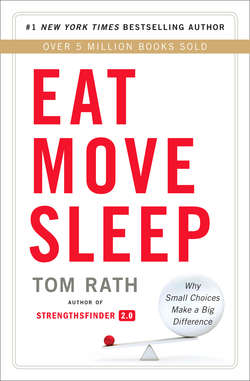Читать книгу Eat Move Sleep - Tom Rath - Страница 14
На сайте Литреса книга снята с продажи.
ОглавлениеGiving Your Immune System a Boost
5
Judge Food by the Color of Its Skin
The benefit of a diet rich in fruits and vegetables is so well-documented it hardly bears repeating. Eating the right natural foods wards off disease, enables you to live longer, makes you look better, and gives you additional energy. Yet most people fail to eat enough fruits and vegetables but consume large quantities of unnecessary foods.
However, we do not have a quick way to determine what foods are the healthiest. We receive conflicting advice from different sources. Then we face countless choices every time we go shopping at a grocery store or place an order at a restaurant.
An efficient mental shortcut is to judge a fruit or vegetable by the color of its skin. Generally speaking, produce with dark and vibrant colors is your best bet. Green means go. Broccoli, spinach, kale, bok choy, celery, cucumbers, peppers, zucchini, and other dark leafy greens are net positives for your health. Also look to red or blue fruits and vegetables as good nutritional sources. Apples, peppers, raspberries, strawberries, tomatoes, and almost any fruit or vegetable with vibrant skin tone makes for a better choice.
The next time you are in a grocery store, start by shopping in sections with dark-colored fruits and vegetables. Spend as much time as possible in the produce section before loading up on other foods. When you get home, prepare your plate with dark and diverse colors. When you dine out, ask for greens instead of grains. Order what you would normally put on a sandwich on top of spinach or romaine.
A Vaccine for the Common Cold
What if someone told you there was finally a vaccine for the common cold? One experiment suggests a good night’s sleep may be the answer. Participants in this study reported their sleep quality for 14 consecutive nights. Then they were quarantined and given nasal drops containing a rhinovirus (common cold). Researchers monitored participants for the next five days to see if they developed a cold. This experiment revealed that the participants who typically had less than seven hours of sleep before being exposed to the rhinovirus were nearly three times as likely to develop a cold.
Even though you cannot see it, a sound night’s sleep alters what is going on inside your body. Sleep deprivation raises blood pressure, increases inflammation, and boosts the risk of heart disease and stroke. These outcomes suggest sleep is an even higher priority when you are likely to catch a cold or the flu.
During cold and flu season, for example, your immune system may need enough sleep to ward off the latest strain going around your office. When your sleep routine is at risk, due to travel or any other reason, plan your schedule to get the right amount of sleep. This will help to keep your natural defenses high when you are at an increased risk of getting sick.
Quality Beats Quantity in Bed
It is easy to spend eight hours in bed and still feel lousy in the morning. You can spend nine hours in bed yet get just five hours of good sleep. The problem is, time spent rolling around awake in bed doesn’t count. Nor is it healthy if you are regularly getting up in the middle of the night and struggling to fall back to sleep.
As part of the experiment in the previous section in which people were quarantined and injected with a rhinovirus, participants were also graded on the quality or efficiency of their sleep. To determine the “sleep efficiency” scores for each participant, researchers asked what time they went to sleep, what time they got up, how much time they spent in bed before falling asleep, how many times they awoke, and how long they were up throughout the night. The sleep efficiency score was then calculated based on the percentage of time participants slept out of the total time they were in bed.
The researchers discovered that sleep efficiency is more influential than the total duration of sleep, at least when it comes to warding off the common cold. Participants who had lower sleep efficiency scores over the 14-day period before exposure to the rhinovirus were 5.5 times as likely to develop a cold. Quality of sleep beat quantity by a wide margin.
Set yourself up for quality sleep first. Consider your diet, activity, and environment. Then focus on extending how long you sleep.
Every time you go to the store, start by loading up on fruits and vegetables with vibrant colors.
When disruptions threaten your regular schedule, plan ahead to ensure you get a good night’s sleep.
As you make adjustments for better sleep, measure your progress. Note the time you get into bed and the time you wake up. Then rate your sleep quality on a 1-10 scale.
